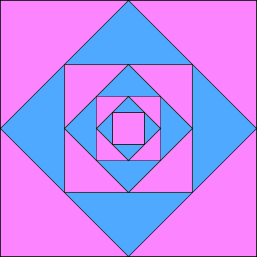Or search by topic
Number and algebra
Geometry and measure
Probability and statistics
Working mathematically
Advanced mathematics
For younger learners
Diminishing Returns



- Problem
- Getting Started
- Student Solutions
- Teachers' Resources
Why do this problem
The problem offers opportunities to think about area, proportion and fractions, while offering an informal introduction to the mathematics of infinity and convergence which would not normally be met by younger students, to tempt their curiosity.
Possible approach

Show the first image from the problem for a short while and invite students to look at it in silence. Then hide the image and give them some time to reflect on what they saw and then discuss with a partner, and finally share with the whole class.
"What did you see?"
"Did anyone see it differently?"
Once students have shared their thoughts, show them the image again to see how their impressions of it compared with the actual picture. Then pose the following question:
"What questions might a mathematician want to explore?"
Give them some time to come up with some suggestions. If they are struggling to think of any, there are some suggestions in the "Key questions" section below.
You might like to finish off with a discussion about what would happen if the patterns carried on forever. This is explored some more in the problem Vanishing Point.
Key questions
- For the first stage of the pattern, how many blue triangles are there? What about at the second... third... fourth stage?
- How do the areas of each blue triangle compare with the next size up?
- How could I create the image from coloured paper?
- What proportion of the image is shaded blue?
- What if it carried on forever?
Possible support
In the Teachers' Resources to Inside Seven Squares there is a demonstration of how paper folding could be used to help students to create the shapes, and see the relationship between areas.
Possible extension
Vanishing Point uses the same starting point and goes on to explore the question of continuing the sequence indefinitely.
You may also like
Tweedle Dum and Tweedle Dee
Two brothers were left some money, amounting to an exact number of pounds, to divide between them. DEE undertook the division. "But your heap is larger than mine!" cried DUM...
Sum Equals Product
The sum of the numbers 4 and 1 [1/3] is the same as the product of 4 and 1 [1/3]; that is to say 4 + 1 [1/3] = 4 � 1 [1/3]. What other numbers have the sum equal to the product and can this be so for any whole numbers?
Special Sums and Products
Find some examples of pairs of numbers such that their sum is a factor of their product. eg. 4 + 12 = 16 and 4 × 12 = 48 and 16 is a factor of 48.

